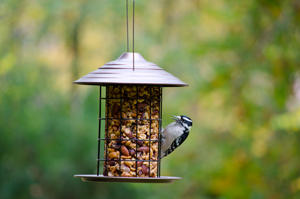Fewer Birds at Your Feeders?
Less Activity at Your Feeders? Don't Worry.
We're hearing it from many customers, and we're seeing it for ourselves at our home feeders. "The birds aren't eating." Well, actually they are, but here are some likely reasons why feeder activity has diminished over the last few weeks:
- Abundant Natural Food: Feeder use is typically slow during the fall and early winter because natural food sources, such as seeds, tree nuts and berries, are at their greatest abundance.
- Feeder use is typically slow during the fall and early winter because natural food sources, such as seeds, tree nuts and berries, are at their greatest abundance.
- Add Bark Butter to attract migrating species & cater to caching species in fall when other bird are less active…such as adding peanuts for caching Blue Jays
- It appears that in much of our region, this year's growing season was much better than it has been for a number of years. Natural food sources such as weed seeds, nuts, fruit and even insects are more readily available for birds this year. Lots of natural food means fewer birds at our feeders, and it is important to understand that feeder birds still gravitate to natural foods at a much higher percentage (75-80% of their diet) than they do the supplemental foods we offer in feeders. When natural foods are abundant…birds seek them out first and truly use our feeders as a supplemental source of food when needed.
Bottom line: don't be discouraged! As natural resources dwindle, your feeders will once again be the popular source for food. We certainly encourage offering fresh seed (perhaps purchase 5# or 10# bags until demand picks up), keeping your feeders clean, and maintaining a source for water. We highly recommend keeping at least one finch (Goldfinches, New Jersey's state bird, is here year round) feeder and one foundational feeder up.


